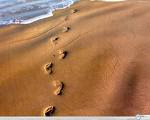WHAT ARE HAMMERTOES?
A hammertoe is a deformity of the middle toe joint that can occur in the 2nd, 3rd, or 4th toes. The toe is peranently bent into what looks like a upside down "V". It is the result of wearing poor-fitting shoes or high heels or shoes that are too short or even too narrow.
When the toe is bent like this for a long period of time the muscles in the toe will shorten which leads to the defority.
Because of the pressure on this bent toe joint the toe rubs in the shoe and corns or calluses can form on top of the toe in the middle joint or on the tip of the toe. This can cause even more pain.
Thursday, December 31, 2009
Thursday, December 24, 2009
SURGICAL TREATMENT OF AN INGROWN TOENAIL:
Often times the best way to remove an ingrown is with a minor surgery It is a simple procedure and very successful for long term relief that is permanent. This is performed under a local anesthetic in the physician's office. The most common procedure is the removal of a portion of the nail that is causing the problem. After the offending part of the nail is removd an acid is used to destroy the root to prevent regrowth. Some people experience some discomfort afterwards, but it is usually very minimal. At the Advanced Foot Care clinic we recommend using Amerigel afterwards for two weekis. This cream helps the area to heal faster and debrides any other infection that is in the area removed. An open toe shoe should be worn if possible so that there is no pressure on the area to help healing.
Often times the best way to remove an ingrown is with a minor surgery It is a simple procedure and very successful for long term relief that is permanent. This is performed under a local anesthetic in the physician's office. The most common procedure is the removal of a portion of the nail that is causing the problem. After the offending part of the nail is removd an acid is used to destroy the root to prevent regrowth. Some people experience some discomfort afterwards, but it is usually very minimal. At the Advanced Foot Care clinic we recommend using Amerigel afterwards for two weekis. This cream helps the area to heal faster and debrides any other infection that is in the area removed. An open toe shoe should be worn if possible so that there is no pressure on the area to help healing.
Wednesday, December 23, 2009
Stretch Your Muscles
 Are your muscles feeling tight? Are you experiencing pain in your feet or calves? A good way to relieve the pain you may be experiencing, or to just keep your body healthy, is to stretch your feet and calves.
Are your muscles feeling tight? Are you experiencing pain in your feet or calves? A good way to relieve the pain you may be experiencing, or to just keep your body healthy, is to stretch your feet and calves.Here's an easy exercise that you can do when you wake up in the morning, before getting out of bed:
Towel Exercise: With no shoes on, place a towel or resistance band around the bottom of your feet at the ball area. Pull on both ends of the towel or resistance band while flexing your foot. Push your foot up and back 10 times, turn your foot to the right, flex your foot up and back 10 times in this position. Repeat for the other foot.
Friday, December 18, 2009
Ingrown Toenail Symptoms
Ingrown toenail is a common disorder that most often affects the outer edge of the big toe. However, the nail on any toe, or the nail on both sides of a toe, can become ingrown. The most common signs and symptoms are pain, redness, and swelling at the corner of a toenail.
At first you may notice the sides of the toe becoming red and painful with some swelling. There may not be any drainage.
If not taken care of extra skin and tissue will grow around the sharp point of the nail. A yellowish drainage may begin. This is the body's response to the trauma of a nail irritating the skin and is not necessarily an infection.
Sometimes an infection develops. In this case, the swelling will become worse, and there may be white- or yellow-colored drainage from the area. A lighter-colored area of the skin may be surrounded by red skin.
Ingrown toenail is a common disorder that most often affects the outer edge of the big toe. However, the nail on any toe, or the nail on both sides of a toe, can become ingrown. The most common signs and symptoms are pain, redness, and swelling at the corner of a toenail.
At first you may notice the sides of the toe becoming red and painful with some swelling. There may not be any drainage.
If not taken care of extra skin and tissue will grow around the sharp point of the nail. A yellowish drainage may begin. This is the body's response to the trauma of a nail irritating the skin and is not necessarily an infection.
Sometimes an infection develops. In this case, the swelling will become worse, and there may be white- or yellow-colored drainage from the area. A lighter-colored area of the skin may be surrounded by red skin.
Friday, December 11, 2009
Clarifying Hammertoes

Just what exactly are hammertoes and what causes this affliction? These are common questions related to a common toe deformity. In this excerpt, it is our intent to provide a brief explanation for the occurrence of hammertoes.
Hammertoes originate as a muscle imbalance due to the onset of a variety of events--usually flat feet, traumatic injury, or a disease of the toe joints. These events influence the placement of individual toe muscles--the "flexor digitorum longus" muscle and the "flexor digitorum brevis" muscle specifically--which are respectively located at the end and middle of the toe. Each of these muscles overpower the other muscles found in the toe upon being triggered by events such as having flat feet or contracting a toe joint disease. This, as a result, causes one of two problems.
As chronicled by PodiatryChannel.com, the following synopses cited explain these two problems in more detail:
First Problem. "If the flexor digitorum brevis contracts first and overpowers the rest of the muscles in the toe, the middle phalanx (middle bone) is pulled downward, causing the joint between the proximal and middle phalanges to buckle upward. This is known as a claw toe. "
Second Problem. "If the flexor digitorum longus contracts first and overpowers the smaller muscles, it can pull on the proximal phalanx, causing the outer two joints of the toe to bend downward. This results in a hammertoe."
As always, if you are seeking more information about the hammertoe condition, or any other foot health-related condition, please consult with one of the podiatric professionals at Advanced Footcare Clinic at any point in time.
Thursday, December 10, 2009
WHAT CAUSES AN INGROWN TOENAIL?
An ingrown can be caused by tight-fitting shoes or high heels that cause the toes to be compressed together and pressures the nail to grow abnormally.
Also if you trim your nails too short. Be sure to trim straight across
Disorders such as fungal infections of the nail can cause a thickened or widened toenail to develop.
Either an acute injury near the nail or anything that causes the nail to be damaged repetitively (such as playing soccer) can also cause an ingrown nail.
Also the tendency to get ingrown toenails is genetic. If a member of your family has an ingrown toenail, then you are more likely to develop one, too. Some people's nails are normally more rounded than others, which increases the chance of developing ingrown nails.
An ingrown can be caused by tight-fitting shoes or high heels that cause the toes to be compressed together and pressures the nail to grow abnormally.
Also if you trim your nails too short. Be sure to trim straight across
Disorders such as fungal infections of the nail can cause a thickened or widened toenail to develop.
Either an acute injury near the nail or anything that causes the nail to be damaged repetitively (such as playing soccer) can also cause an ingrown nail.
Also the tendency to get ingrown toenails is genetic. If a member of your family has an ingrown toenail, then you are more likely to develop one, too. Some people's nails are normally more rounded than others, which increases the chance of developing ingrown nails.
Thursday, December 3, 2009
This is from APMA (American Podiatric Medical Association)
WHAT IS CAUSING MY HEEL PAIN?
The number one cause of this pain is condition called plantar fascitis. It is characterized by pain on the bottom of the heel when you take your first step in the morning, but it can also last all day long, often progressing the longer the condition remains untreated. Other common causes of heel pain include tendinitis, stress fractures, neuritis, bursitis, tarsal tunnel syndrome, arthritis and fat pad thinning.
Plantar fascitis can be caused by a number of factors, including weight gain, worn-out shoes, walking barefoot, increasing exercise and walking on hard surfaces without proper support.
WHAT IS CAUSING MY HEEL PAIN?
The number one cause of this pain is condition called plantar fascitis. It is characterized by pain on the bottom of the heel when you take your first step in the morning, but it can also last all day long, often progressing the longer the condition remains untreated. Other common causes of heel pain include tendinitis, stress fractures, neuritis, bursitis, tarsal tunnel syndrome, arthritis and fat pad thinning.
Plantar fascitis can be caused by a number of factors, including weight gain, worn-out shoes, walking barefoot, increasing exercise and walking on hard surfaces without proper support.
Subscribe to:
Posts (Atom)




